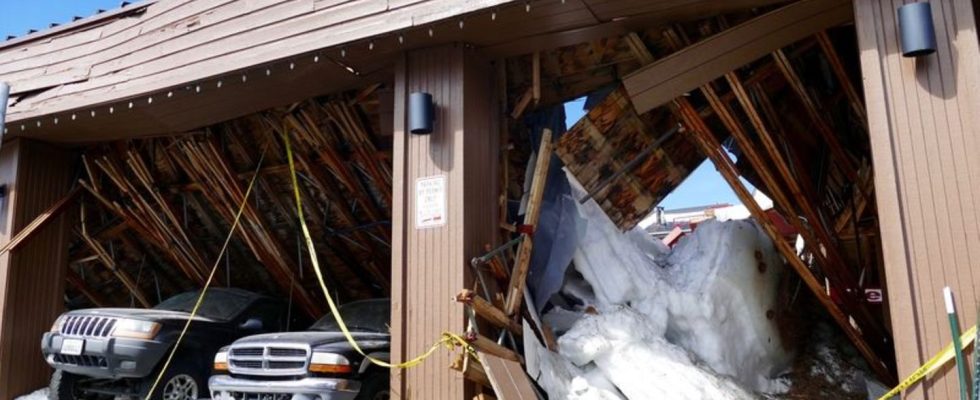Environment
Snow records in California – worry about flooding
Masses of snow have brought down a garage. photo
© Barbara Munker/dpa
Shoveling snow in April, skiing until July – and that in the sunny state of California? After winter extremes with snow records, there is now a risk of flooding.
Meter-high mountains of snow pile up in front of the houses. Roofs are shoveled free so that they don’t collapse under the weight of the snow masses.
The ski lifts will be in operation at least until the end of July – this is how the operators of Mammoth Mountain, one of the largest ski resorts on the eastern side of the Sierra Nevada, advertise. A good six hours’ drive northeast of Los Angeles, around the town of Mammoth Lakes, it’s still deep winter.
Record snowfall in the winter and spring months gave the winter sports resort slopes that one can only dream of in Europe after a winter with little snow. But the white splendor comes with a downside. After massive storms with rain and snow in recent months, the usually sun-drenched US West Coast is grappling with nightmare scenarios. With the snowmelt now beginning, massive flooding is expected after many years of drought. And in Mammoth Lakes, located at an altitude of 2400 meters, the residents still have to shovel their way out of the masses of snow in mid-April.
“We’re fed up,” says Maximilian Laue, who was born in Berlin. “One storm after the other” completely covered the place. He has lived near Mammoth Lakes for eight years. He has never seen so much snow, says the 41-year-old. He is a shuttle driver for the Eastern Sierra Transit association, which also takes skiers to the lifts with their buses. The roads were often impassable. Laue also reports of collapsed roofs and house beams bent under the weight of snow.
High wall of snow
The resort has measured 18 meters of snow since the start of the season in November, ten meters is the norm. “The best winter in our history,” the operators cheer about the record. The heaviest storms hit the region in March, but everything is still covered in deep snow in mid-April. Heavily loaded trucks rattle through the village non-stop, transporting the mountains of snow away. “There’s just not enough room here for all that snow,” says Dan McConnell, operator of local television station The Mammoth Channel. His house is still surrounded by a nine meter high white wall.
Meter-high walls of snow line the sidewalks. Thick blocks of ice press on roofs, parked cars are hopelessly buried. Only the top half of the mammoth mascot, a giant mammoth sculpture in front of the gondola station, sticks out of the snow.
The deepest snow cover in 90 years was measured in the central and southern part of the Sierra Nevada mountain range, the weather agency NOAA said in early April via its National Integrated Drought Information System (NIDIS), which studies precipitation with a view to drought forecasts.
“Pure Madness”
A similar picture in Northern California, around Lake Tahoe, with the well-known Palisades Tahoe ski area (formerly Squaw Valley/ Alpine Meadows), host of the 1960 Winter Olympics. The lifts would run until early July this time, spokesman Patrick Lacey said last year was already over at the beginning of May.
Almost four meters of snow fell in just one week in March. “It was insane digging everything up,” says Lacey. Because of “too much of a good thing” they wouldn’t have gotten the lifts to work on some days. After bright sunshine at the weekend, fresh snow was expected again on Tuesday.
After the endless winter, the west coast state is now preparing for flooding. The climate researcher Daniel Swain wrote on Twitter on Monday that a strong water runoff from the mountainous regions is to be expected. Most of the water is still bound in the snow cover, but the melting will start quickly as temperatures rise. Swain warns of a “significant risk”. The current floods are only “a foretaste”.
Damages in the billions expected
In the district of Tulare County in California’s Central Valley, heavy rain and the beginning of snowmelt have already submerged large areas of land. The bed of the former Tulare Lake, which has dried up for decades and is now used for agriculture, is particularly affected. Authorities had diverted water from the heavily swollen Kings River to the region. The US space agency Nasa recently published satellite photos of the flooded region. Agricultural experts expect damage in the billions.
The famous song “It Never Rains in Southern California” – it never rains in southern California – does not currently describe the situation. On the contrary. The west coast state has repeatedly been hit by unusually heavy rainfall in recent months. The reason is a weather phenomenon called “atmospheric flow”, a band of moisture-saturated air.
These severe storms and flooding are the latest evidence that California’s climate is becoming increasingly extreme, State Water Administration (DWR) chief Karla Nemeth said in a recent statement. After three severe years of drought, forecasts and help with floods and snowmelt must now be quickly switched to.

